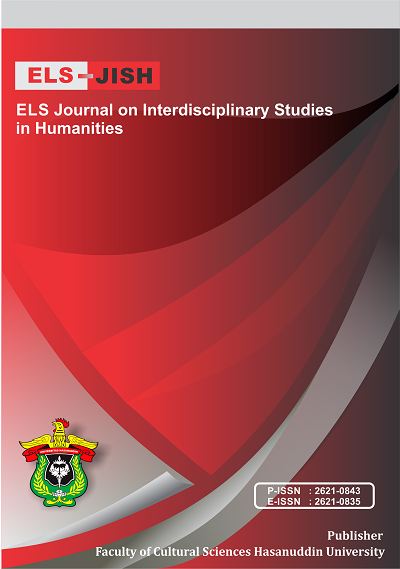The Absence of Color Concept in Pelauw Language (an NSM Approach)
DOI:
https://doi.org/10.34050/elsjish.v6i2.27311Keywords:
Colour concept, manggahina and mete, NSM, Pelauw languageAbstract
The notion of colour has been an interesting yet controversial topic especially in the field of linguistics. Some scholars (Berlin and Kay, 1969) argued that every human being should have an insight of the basic colour terms as the universal inventory since the beginning. While other scholar (Wierzbicka, 1996) argued that rather than the colour concept as an inherent nature, it should be a dependant nature in which its terms was emerged because of what have been seen before. This long debate over the colour concept ties to a phenomenon that occurs in one of the indigenous languages in the Eastern part of Indonesia, namely Pelauw. This language apparently does not have any colour terms in its vocabulary as all the words for colour found in this language are borrowed from Bahasa Indonesia. To investigate this strange phenomenon, therefore, this paper will aim to examine the absence of colour concept in Pelauw language, and to use Natural Semantic Metalanguage (NSM) approach (Goddard and Wierzbicka, 2014) for analyzing the terms ‘manggahina’ and ‘mete’ which are somehow used to address white and black colours, respectively. This study uses a qualitative approach with descriptive methods to explain the phenomenon under study using NSM, which in this case, the absence of colour concept in Pelauw language. The results show that colour concept is not something which universally exists to begin with, instead, it is just a result of what have been seen through the vision that visualised and emerged as the colour terms. It is attested through the analysis of terms ‘manggahina’ and ‘mete’ using NSM which concludes that these terms are rather a visual descriptor than a colour concept.
References
Andini, C., Sosrohadi, S., Fairuz, F., Dalyan, M., Rahman, F. F., & Hasnia, H. (2022). The Study of Japanese Women in the Facial Treatment Advertisement: A Semiotics Perspective of Pierce’s Theory. ELS Journal on Interdisciplinary Studies in Humanities, 5(2), 337-347.
Berlin, B. Kay, P. (1969). Basic color terms: their universality and evolution. Berkeley: University of California Press.
Gleason Jr, H. A. (1955). An introduction to descriptive linguistics, Rev.
Goddard, C. (2006). Ethnopragmatics: A new paradigm. Applications of Cognitive Linguistics, 3, 1.
Goddard, C. (2007). Semantic molecules. Research-repository.griffith.edu
Goddard, C. and Wierzbicka, A. (2014). Semantic fieldwork and lexical universals. Studies in Language. International Journal sponsored by the Foundation “Foundations of Language”, 38(1), pp.80-127.
Heider, E. R. (1972). Universals in color naming and memory. Journal of experimental psychology, 93(1), 10.
Huettig, F., Guerra, E., & Helo, A. (2020). Towards understanding the task dependency of embodied language processing: the influence of colour during language-vision interactions. Journal of Cognition, 3(1).
McNeill, N. B. (1972). Colour and colour terminology. Journal of linguistics, 8(1), 21-33.
Rahman, F., & Weda, S. (2019). Linguistic deviation and the rhetoric figures in Shakespeare’s selected plays. XLinguage" European Scientific Language Journal", 12(1), 37-52.
Saysani, A., Corballis, M. C., & Corballis, P. M. (2021). Seeing colour through language: Colour knowledge in the blind and sighted. Visual Cognition, 29(1), 63-71.
Siuda-Krzywicka, K., Witzel, C., Taga, M., Delanoe, M., Cohen, L., & Bartolomeo, P. (2020). When colours split from objects: The disconnection of colour perception from colour language and colour knowledge. Cognitive Neuropsychology, 37(5-6), 325-339.
Wicaksono, H., Rahman, F., & Sahib, H. (2021). Light Sign Communication Between Pilot and ATC: Language Function and Semiotics Analysis. American Journal of Humanities and Social Sciences Research, 5(11), 176-185.
Wicaksono, H., Rahman, F., & Sahib, H. (2020, October). The ineffective way of using gun light to deliver light sign for aircraft with total radio failure or receiver failure. In IOP Conference Series: Earth and Environmental Science (Vol. 575, No. 1, p. 012179). IOP Publishing.
Wierzbicka, A. (1996). Semantics: Primes and universals: Primes and universals. Oxford University Press, UK
Wierzbicka, A. (2005). There are no" color universals" but there are universals of visual semantics. Anthropological linguistics, 217-244.
Zahan, D. (1951). Les couleurs chez les Bambara du Soudan français. Notes africaines, 50, 52-56.
Downloads
Published
Issue
Section
License
Copyright (c) 2023 Ahmad Rifani Talaohu, Nurhadi Hamka

This work is licensed under a Creative Commons Attribution-ShareAlike 4.0 International License.






